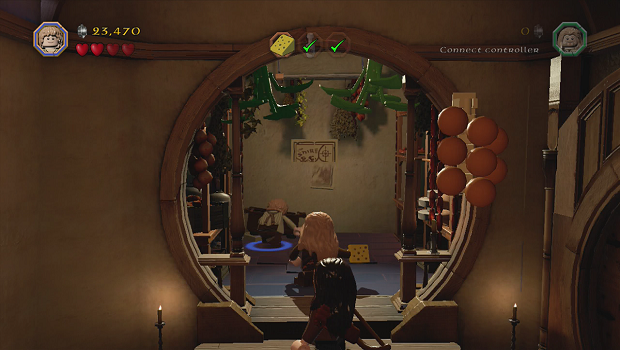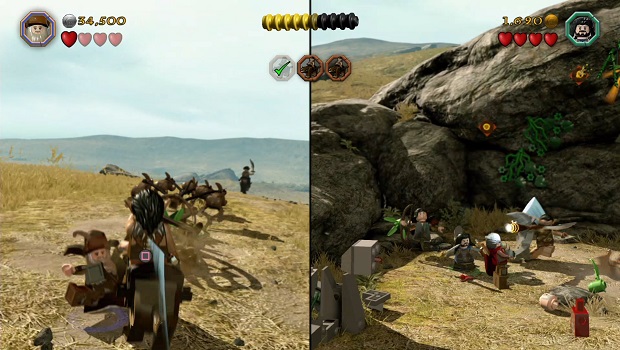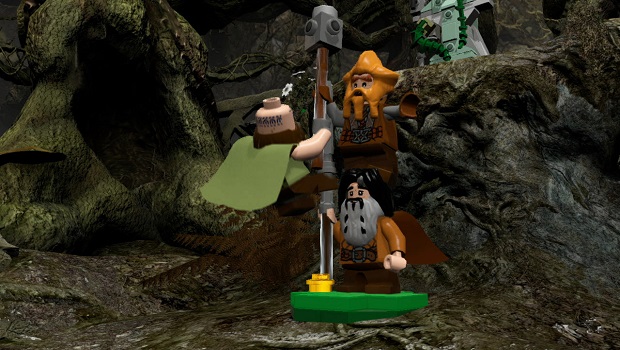Lego games have come so far. Far from being simple cash grabs, recent efforts have proven to be quite entertaining with compelling gameplay and loads of interesting things to do. Lego Marvel Super Heroes was one of the top games of the 2013, with a massive cast of diverse characters, a huge world with so many different and interesting things to do, and a fun story with great acting. With these things in mind, I found myself quite excited to finally dive deep into Lego: The Hobbit.
Based on Peter Jackson’s new series of Hobbit movies, Lego The Hobbit follows Bilbo’s journey to the lonely mountain in classic Lego style. If you’ve ever played a Lego game, you’ll find yourself in an instantly familiar control scheme, guiding your hobbit, dwarf or wizard through various parts of the adventure, beating up goblins, collecting studs, and solving puzzles. The standard fare is all present, as are some new additions to liven things up- though I wouldn’t describe these changes as overwhelmingly successful. Indeed, some of them add needless complication and busywork to a series that had seemingly turned the corner from this sort of things a while ago.
Lego The Hobbit has the required “build a random object to continue to move through the level” portions of the Lego trope. These almost always result in a fun, completely random animated sequence. Yet, getting to that sequence has been muddied up a bit by the occasional forced crafting portion. You see, in order to build your catapult, or bridge or what have you, you’ll need to collect the necessary materials. Getting the materials themselves isn’t particularly difficult, as they are layered on thick in every level and on the overworld map. Yet, there are a ton of different types of materials, and actually building objects requires going through a tedious process of selecting each individual material and adding it to the build. Upon completion, you’ll be taken to a separate screen, where you’ll see the item being built. At points, you’ll be asked to choose which block goes next- be fast and accurate and you’ll get a huge stud bonus. A lot of the blocks look the same, however, so, good luck. The entire process seems overly complex and unnecessary. Thankfully, it’s not required for every construction, but it does pop up about once every level.
The campaign will take you through all of the first two Hobbit movies. Characters are voiced using recordings from the movies, to varying success. Some of the sequences, especially the encounter with Smaug near the end, have really poorly mixed sound, to the point of distraction. The pre- and post-level narration is new, and done by the actor who voices Saruman (Christopher Lee), and seems a bit more fitting. The levels themselves do an excellent job following the movies (though pains are taken to add extra characters so that co-op is available even at points when Gandalf or Bilbo were alone, to great comedic effect).
The game overworld opens up as you complete levels, and finishing the campaign will leave you with a massive landscape with a ton of different quests and activities to complete. You’ll have your fill of Lego goodness at this point. The post-campaign quests have much more variety than, say, the previous Lego Lord of the Rings game (which was filled with far too many fetch questions). If you’re looking for lots of Lego action, you’ll get plenty of that. The map is so big that they’ve added locations where you can get picked up by the Eagles and flown somewhere else on the map. I highly recommend it (so much better than fast travel).
The characters are here in all their glory. Bilbo has his ring, which will allow him to disappear from sight. The dwarves are widely varied, some carrying slingshots, some with pickaxes to mine minerals, some with spears so that you can stack them and climbs up higher, and, my personal favorite, Bombur, who you can feed and fatten up to use him as a bouncing platform. My only quibble with the characters is the poor design of the wizards, who can’t seem to figure out how to hit an enemy standing right next to them. One late game boss fight involves Gandalf and Radagast fighting an enemy at range while sword-armed goblins came in close to melee attack. I could not for the life of me hit the enemies who were right next to me, and so died repeatedly. Thankfully, there’s no fail state in a Lego game, but that portion (and really any moment when I controlled a wizard with enemies at arms’ length or closer) was very frustrating.
It’s hard for me to not be slightly disappointed in Lego the Hobbit. After Lego Batman 2 and Lego: Marvel Superheroes, I was really excited to see their second try at Middle Earth. And, while the game is an improvement over the previous Lord of the Rings game, it’s a step back from Traveler’s Tales more immediate work. It’s still a fun Lego experience, and I recommend it to Lego game fans and Hobbit fans alike. But if you were expecting a repeat of the last year’s Lego triumph, this effort is not at that level.
Lego: The Hobbit was review on an Xbox 360 copy provided by the developer and an Xbox One copy purchased by the reviewer.




